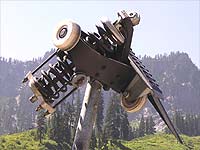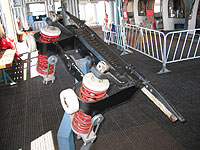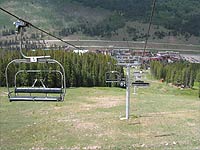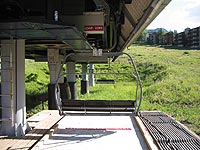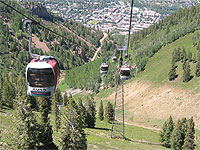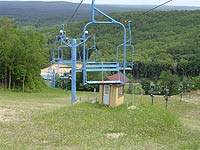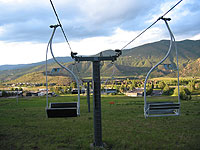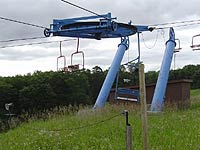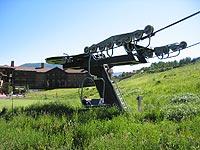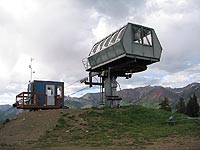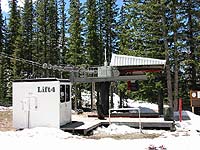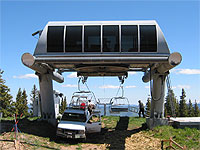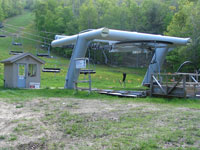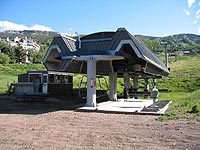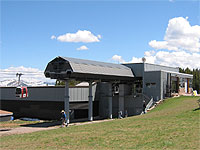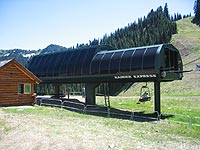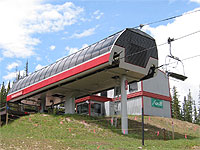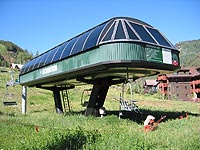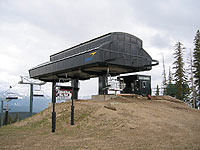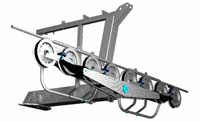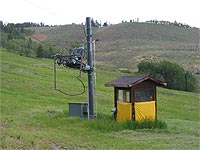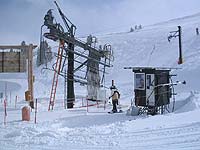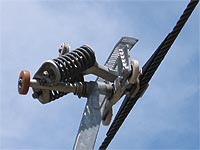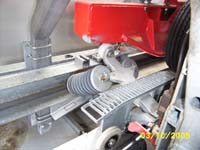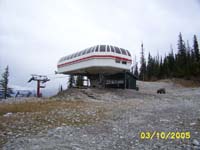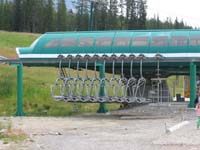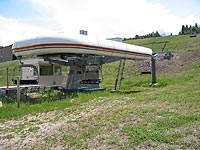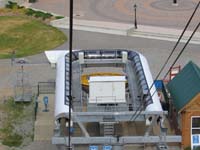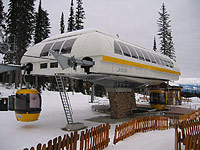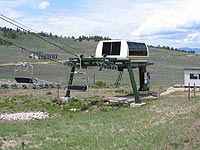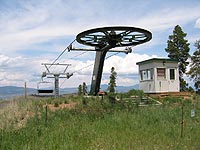Home : Chairlifts :
Facts & Features : Lift ID Sheet : Riblet
Leitner
Poma Identification sheet

This page displays former Poma and Leitner designs as well as current
Leitner-Poma designs.
Poma : Leitner
Poma
| |
TB-41 Grip
(1983-1998)
This was Poma's first detachable grip. It was replaced in
1998 by the Omega T grip and was most commonly used on Poma's
high-speed quads prior to 1998. |
| |
Double TB-41 Grip
(1983-1998)
This is just two TB grips married together as one grip. it
is used for the weight and increased wind resistance of gondola
cabins. |
| |
Omega T Grip
(1998-2006)
This grip was first introduced in 1998 and has been Leitner-Poma
main detachable grip since the retirement of the TB-41 detachable
grip. However, this grip was retired in 2006 and will be replaced
by the new Leitner grip in North America in 2007. |
| |
Competition Carrier
(1989-1991)
This carrier was an alternative to the Falcon carrier, but
had a short life span of only a few years. |
| |
Falcon Carrier
(1983-1997)
This is the primary carrier style from the 80s and mid
90s. It was used, along with the competition, as the carrier
for both fixed and detachable lifts and retired in 1997 and
replaced by the Omega carrier. |
| |
Cabins
This is one of Poma's cabin designs. Most of Poma's
gondolas use CWA but this one does not. It is unique because
it opens up like a clam shell and the passengers sit facing
out instead of in. |
| |
Chairs
This is the 60's style of bail chair. The chairs on this specific
lift have been retrofitted by Riblet but it still shows the
basic design. There are few different versions of these. Take
note that similar designs have been made by other companies
such as Yan, Stadeli, Miner-Denver, and Samson. |
| |
Chairs
This chair was used for a short time after the 70s.
It was used until the Falcon and Competition carriers were
introduced. |
| |
Terminals
This one is the original Poma tension terminal. It does
not have a frame, but rather the carriage floats. It is supported
between the haulrope and the counterweight supports. |
| |
Z Type Return
(1997-Present)
This is the return terminal used for lower stations.
There is a similar version that is used for top stations. |
| |
Delta Terminal
This terminal was used before the Alpha drive was invented.
It can be tensioned or it can be fixed. |
| |
Terminals
This terminal was produced before the delta terminal
was used on fixed grips. It is probably the most recent drive
with the motor exposed to the elements. |
| |
Terminals
This is a return that was used before the monopod and bipod
return terminals were invented. this particular one may also
have tensioning. |
| |
Alpha Terminal
This is the current style of terminal used on Leitner-Poma
fixed grip lifts. It is a drive/tension combo and can be seen
at the bottom or top of lift. |
| |
Terminals
While the name of this one is not known, it should be called
the Alpha fixed return because it is basically a return version
of the Alpha. |
| |
Alpha Falcon
(1983-1988)
This is one of the early version of detachable terminals.
It uses an Alpha drive fixed grip terminal with a Falcon detachable
terminal in front of it. There is also a version of this terminal
where a vault drive is used instead of the alpha terminal.
On the vault drive version, the drive is located under the
Falcon terminal. |
| |
Falcon Terminal
(1983-1988)
Seen here is the same thing as above but it is a return terminal
and the bullwheel is located on the inside of the terminal.
The chair parking rail is located where the Alpha drive would
be. |
| |
Falcon Gondola
Terminal (1983-N/A)
The Falcon terminal was also used for many of POMA's
gondolas. |
| |
N/A (1988)
This was Poma of America's first attempt in designing
its own detachable chairlift for the North American market.
It was used after the Falcon terminal for only one year before
the Competition terminal was introduced the fallowing year. |
| |
Competition Terminal
(1989)
This is the Competition terminal which was introduced
in 1989 and was only manufactured for one year before being
replaced by the Challenger terminal the fallowing year. |
| |
Challenger Terminal
(1990-1998)
The Challenger terminal was the second detachable chairlift
design by POMA of America and was used by POMA of America
for eight years before being retired in 1998. POMA did make
some aesthetic changes to the terminal design in 1994 but
the design was still the same. While this lift was designed
for the North American market, a few of these terminals were
shipped over to France. |
| |
Challenger Terminal
(1990-1998)
In 1994, POMA of America made some minor aesthetic changes
to its Challenger terminal design. |
| |
Competition Gondola
Terminal (1996-1998)
Even though this terminal looks just like the Challenger
terminal, except on a larger scale, this terminal was known
as the Competition terminal and was the main terminal used
on POMA's gondolas during the period. |
| |
Satellit Terminal
(N/A-Present)
The Satellit is a design that is not made by -Poma of America,
but rather Poma of Europe. It's the prevelent terminal in
every other country except the U.S. and Canada. |
| |
Phatboy Terminal
(1998-Present)
This terminal is often called "the stack"
because it is an Omega terminal with an extra section added
to it. The return terminals do not have the extra rise and
look like the regular Omega terminals. The term "Phatboy"
was first introduced in 2000 when the Quicksilver Express
at Breckenridge was built. |
| |
Omega Terminal
(1998-Present)
This is a next version of the current Leitner-Poma Omega
detachable terminal which came out in 2003. This model is
the most current one and does not have as many windows on
the front of it because of a small design error with the previous
model. The windows were removed because when chairs were on
the emergency rail, the two windows right above the rail were
unable to be closed due to strain. This allowed for snow to
easily enter the terminal anytime a chair was parked on the
rail. |
| |
Sheaves
These are the Poma 5-spoke sheaves. They were used on
lifts during the 60s, and were used on depression applications
during the 80s. They are used on the 80's fixed grips along
with a slightly larger 6-spoke version. |
| |
Sheaves
This computer model illustrates Leitner-Poma's current
sheave design. There claim to fame is that the berings are
grease less and do not have to be lubricated each year. This
is true but there is actually grease sealed inside the bearing.
In the original version of these sheave trains, the bushings
on the on the trains had to be greased but the sheaves themselves
did not. In the mid 90s they changed to all grease less. Picture
thanks to pomagroup.com |
| |
Surface Lift Terminals
A shot of a platter pull terminal. There are sevral versions
of this particular one and they are also used for T-Bars. |
| |
POMA Lift Terminal
No Poma ID guige should be complete without a picture of a
poma lift. This is a detachable platter pull and was the first
type of detachable lift invented. It was originally built
to replace the T-Bar and it's safe to say that it made Poma
the succesful company that it is today because of its popularity
before chair lifts were invented. They continued to be popular
after chairlifts were invented and are sometimes still being
installed to this day. If you see one of these in the U.S.
then it was made by Poma. In Europe however, other companies
have been able to make similar lifts. Poma has counteracted
this by making a Poma lift that can detach at the top for
ease of unload. |
Leitner
While the merger with Leitner has not affected Poma's designs,
Leitner did install some lifts in the U.S. before the merger. This
subsection is dedicated to those lifts.
| |
LA48-95 Grip
Seen here is Leitner's LA48-95 detachable grip. |
| |
LA48-95 Grip
A look at the top of a Leitner LA48-95 grip as it enters the
terminal.
Picture credit to Helper. |
| |
Line
A look at the chairs and towers that are of the Leitner design.
Picture credit to WBSKI. |
| |
Automatic Terminal
- SA4C (1999-2001)
The 1998 Leitner deatchable lifts were called the "Automatic"
series and used the Leitner LA48-95 detachable grip. They
were available in SA4S (Standard Length - 35 tires in the
straight sections) and SA4C (Compact length - 25 tires in
the straight sections).
Picture credit to Helper |
| |
Automatic Terminal
- SA4S (1998-2001)
This is the Leitner Standard Length SA4S Automatic series
drive terminal which has 35 tires in its straight sections.
Picture credit to Helper |
| |
Terminals
and Chairs
Seen here is a Quintessential Leitner terminal with the carriers
on the parking rail.
Picture credit to WBSKI. |
| |
Plan de Gralba
Terminal (low structure) - SA4C Terminal (1999-2001)
This flat line style return terminal is known as Plan De Gralba,
named after the ski area in Italy where this design was first
tested. This terminal model also uses the LA48-95 detachable
grip. These terminals are distinguished by having the walkways
and tires to the inside. |
| |
Plan de Gralba
Terminal (low structure) - SA4C Terminal (1999-2001)
A top view of the flat line style terminal is seen here. You
can see that there is no room to work on the contours compared
to the Omega terminals.
Picture credit to WBSKI. |
| |
Plan de Gralba
Terminal (high structure) - SA4C Terminal (1999-2001)
The drive terminal for the low structure Plan de Gralba
terminal is in this picture. The terminals were available in SA4S (30 tire) and SA4C (25 tire) length.
Picture Credit to WBSKI. |
| |
Plan de Gralba
Terminal (high structure) - SA6C Terminal (1999-2001)
This Plan de Gralba SA6C terminal design which was designed
for six person chairlifts has been converted into a gondola
terminal and uses the Leitner LA612-97 detachable grip and
has the Leitner "LaPerla Alta" cabins.
|
| |
Terminals
This gondola is actually a Poma which was purchased
by Lake Louise and had a custom made terminal skin made for
it to look like the other Leitner lifts at Lake Louise. It
is one of the only times when when a Leitner design was used
on a lift since the merger.
Picture credit to poloxskier.
|
| |
Terminals (N/A-2001)
This is a picture of a drive/tension combo fixed grip terminal.
Notice that the lift uses Poma Omega carriers. This is because
this lift was built during the time when Poma and Leitner
were in the process of consolidating. |
| |
Terminals (N/A-2001)
A Leitner fixed grip return terminal. |
| |
Sheaves
The style of sheaves used on Leitner detachables. |
|


